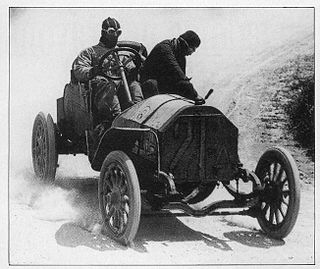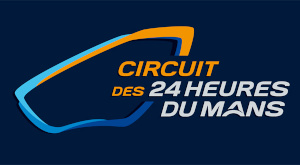
Human-powered transport is the transport of person(s) and/or goods (freight) using human muscle power. Unlike animal-powered transport, human-powered transport has existed since time immemorial in the form of walking, running and swimming, as well as small vehicles such as litters, rickshaws, wheelchairs and wheelbarrows. Modern technology has allowed mechanical advantage devices and machines to enhance human-power.

The World Solar Challenge (WSC), since 2013 named Bridgestone World Solar Challenge, is an international event for solar powered cars driving 3000 kilometres through the Australian outback.

The Targa Florio was a public road endurance automobile race held in the mountains of Sicily near the island's capital of Palermo. Founded in 1906, it was the oldest sports car racing event, part of the World Sportscar Championship between 1955 and 1973. While the first races consisted of a whole tour of the island, the track length in the race's last decades was limited to the 72 km (45 mi) of the Circuito Piccolo delle Madonie, which was lapped 11 times.

AeroVironment, Inc. is an American defense contractor headquartered in Arlington, Virginia, that designs and manufactures unmanned aerial vehicles (UAVs). Paul B. MacCready Jr., a designer of human-powered aircraft, founded the company in 1971. The company is best known for its lightweight human-powered and solar-powered vehicles. The company is the US military's top supplier of small drones —notably the Raven, Switchblade, Wasp and Puma models.

Nuna is the name of a series of crewed solar powered race cars that have won the World Solar Challenge in Australia seven times: in 2001, 2003, 2005, 2007, 2013, 2015 and 2017. The vehicles are built by students who are part of the "Brunel Solar Team" at the Delft University of Technology in the Netherlands, sponsored by Brunel.

The American Solar Challenge (ASC), previously known as the North American Solar Challenge and Sunrayce, is a solar car race across the United States. In the race, teams from colleges and universities throughout North America design, build, test, and race solar-powered vehicles in a long distance road rally-style event. ASC is a test of teamwork, engineering skill, and endurance that stretches across thousands of miles of public roads.

The Circuit des 24 Heures du Mans, also known as Circuit de la Sarthe located in Le Mans, Sarthe, France, is a semi-permanent motorsport race course, chiefly known as the venue for the 24 Hours of Le Mans auto race. Comprising private, race-specific sections of track in addition to public roads which remain accessible most of the year, its present configuration is 13.626 km (8.467 mi) long, making it one of the longest circuits in the world. The capacity of the race stadium, where the short Bugatti Circuit is situated, is 100,000. The Musée des 24 Heures du Mans is a motorsport museum located at the main entrance of the venue.

Tokai University is a private non-sectarian higher education institution located in Tokyo, Japan. It was founded by Dr. Shigeyoshi Matsumae.
Sunswift Racing is the solar car racing team of the University of New South Wales in Sydney, Australia. The team currently holds a number of world records and is best known for its participation in the World Solar Challenge (WSC). Since its founding in 1996 by Byron Kennedy, the Sunswift team has built a total of 7 cars, the most recent of which is Sunswift 7.

The Nuna 3 is a solar car developed by Nuon Solar Team form the Delft University of Technology in 2004-2005 for the 2005 World Solar Challenge.
The Sunraycer was a solar-powered race car designed to compete in the World Solar Challenge, the world's first race featuring solar-powered cars. The Sunraycer was a joint collaboration between General Motors, AeroVironment, and Hughes Aircraft.

The Sasol Solar Challenge is a South African endurance challenge for solar-powered vehicles, with classes for hybrid vehicles, electric vehicles, and biofuel-powered vehicles as well. Recognised by the International Solarcar Federation, the first challenge was run in 2008, and every two years thereafter. The event covers roughly 2,500 km, but has set loops for teams to repeat, with the potential to do 5,000 km. The current record, held by Dutch team Nuon, is 4,716 km, set in 2016 in their car Nuna. The challenge route may change from year to year. In 2022, it ran from Carnival City near Johannesburg to Cape Town over the course of 8 days. The challenge has both local South African teams from both high schools and universities participate, as well as some top-ranking international teams from Japan (Tokai), Belgium and the Netherlands.
The Nuna 4 is a solar car developed by the Delft University of Technology in 2006-2007 for the 2007 World Solar Challenge.

A solar car is a solar vehicle for use on public roads or race tracks. Solar vehicles are electric vehicles that use self-contained solar cells to provide full or partial power to the vehicle via sunlight. Solar vehicles typically contain a rechargeable battery to help regulate and store the energy from the solar cells and from regenerative braking. Some solar cars can be plugged into external power sources to supplement the power of sunlight used to charge their battery.
Solar car racing refers to competitive races of electric vehicles which are powered by solar energy obtained from solar panels on the surface of the car. The first solar car race was the Tour de Sol in 1985 which led to several similar races in Europe, US and Australia. Such challenges are often entered by universities to develop their students' engineering and technological skills, but many business corporations have entered competitions in the past. A small number of high school teams participate in solar car races designed exclusively for high school students.
Nuna 1 was a car powered by solar power, developed by students from the Delft University of Technology.

The Nuna 5 is the 2009 model of the Nuna series solar-powered racing car built by the Dutch Nuon Solar Team.
MITSUBA Corporation or simply MITSUBA, is a Japanese manufacturer of automobile parts including electrical components for wiper systems, door mirrors, power window motors, fuel pumps, and pressure regulators.

Stella and its successors Stella Lux, Stella Vie and Stella Era are a series of solar racing family cars, built for the World Solar Challenge in Australia, sofar winning its Cruiser Class all four times it was held – in 2013, 2015, 2017 and in 2019. Stella is considered the world’s first solar-powered family car and was given the 'Best Technology Development' Award at the 8th annual Crunchies in San Francisco in 2015. Being the only competing vehicle with a license plate, the road registration of Stella contributed to the winning score in the races. The vehicles are designed and built by "Solar Team Eindhoven" (STE) — some 26 students of different faculties of the Eindhoven University of Technology (TU/e) in the Netherlands. The group have set up a non-profit foundation to promote their concepts for practical solar vehicles for adoption on a broader scale.

Phil Sharp is a British yachtsman. He was born in Jersey, educated at Victoria College Jersey and qualified from Imperial College London with an MSc in Mechanical Engineering. Sharp holds World Speed Sailing Records. and Guinness World Records for the Cowes-to-Dinard monohull under 60 ft singlehanded, and crewed around Britain and Ireland under 40 ft.
















